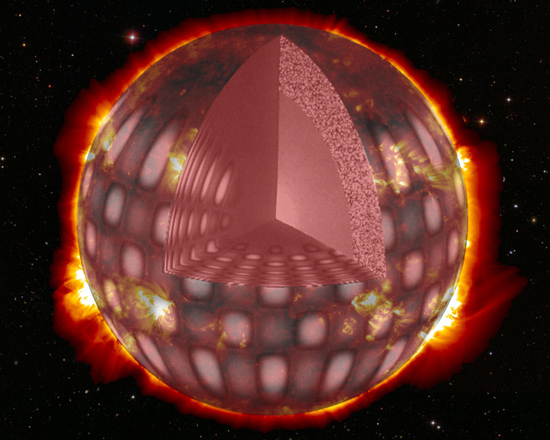[/caption]Observing a stars brightness pulsate may reveal its internal structure say researchers using the Convection Rotation and Planetary Transits (CoRoT) observatory. The highly sensitive orbital telescope can detect tiny variations in a distant star’s brightness, leading astronomers into a new field of stellar seismology called “asteroseismology.”
Seismology is more commonly used by scientists on Earth to see how waves travel through the terrestrial crust, thereby revealing the structure of the material below us. Even solar physicists use the method of helioseismology to understand the interior of our Sun by observing its wobble. Now, by observing the slight changes in stellar brightness, it is possible to remotely probe deep into the inner workings of a distant star…
CoRoT is a joint French Space Agency (CNES) and European Space Agency (ESA) mission to detect slight variations in the brightness of stars launched in 2006. As extrasolar planets pass in front of (or “transit”) a star, the brightness will decrease. The highly sensitive 27 cm-diameter telescope and spectroscopic instrumentation has the ability of detecting extrasolar rocky planets a few times the size of Earth and new gas giants (a.k.a. Hot Jupiters).
Another mission objective for the 630 kg satellite is to detect luminosity variations associated with acoustic pulsations passing through the body of the star. A similar method known as helioseismology uses the Solar and Heliospheric Observatory (SOHO) to detect the propagation of pressure waves through the Sun so a better idea of solar internal dynamics and structure can be gained.
CoRoT has been watching three stars, 20-40% more massive than the Sun, vibrate in reaction to the convective processes on the stellar surfaces. Some areas will expand and cool, whilst others with contract and heat up. This creates an oscillation, and a pulsation in brightness, providing information about the inner structure of these distant stars. The three stars brightened and dimmed 1.5 times more dramatically than solar helioseismology observations. However, this is still 25% weaker than expected from theory, so it would seem stellar physics still has a long way to go.
“This really marks the start of a completely new era of space-based asteroseismology,” said Joergen Christensen-Dalsgaard of the University of Aarhus in Denmark. “It shows that CoRoT can do what it set out to do.”
Asteroseismology can also be used to gauge the precise age of a star. Usually, the age of a star is determined by looking at a star cluster where it is assumed the majority of the stars are of a similar age. However, as a star ages, different elements undergo nuclear fusion at different times. This alters the star’s interior structure and therefore alters the vibrational characteristics of the star. This can be detected by CoRoT, hopefully aiding astronomers when deducing the precise ago of a particular star.
“In principle, you can look at one star all on its own and determine how old it is,” adds Michael Montgomery of the University of Texas.
Source: New Scientist


The BBC News website has some very interesting sounds related to this, see the article at:
http://news.bbc.co.uk/2/hi/science/nature/7687286.stm
…I think this is an interesting approach! And listening to the globular cluster, it seems the stars are singing together!
I am highly skeptical of this method. I call BS (and I don’t mean Bachelor of Science) on this method! Stars are far too hot to have seismology or tectonic plates, such a vibration anomally is much better explained by electrocosmos than by tectonics.
When I say “electrocosmos” I don’t buy into the entire theory, just bits and pieces of it that I like. Perhaps the vibrations are related to plasma capacitance and inductance in the inner core of the stars? Perhaps superfusion occurs due to electrostatic ionic pressures, thereby causing super atoms to form in the core, there are all sorts of electrical phenomina that needs to be investigated for the time being.
“I call BS (and I don’t mean Bachelor of Science) on this method! Stars are far too hot to have seismology or tectonic plates,”
Jesus Christ – plate tectonics? You have no idea of the physics being discussed here, do you? Hint – it has nothing to do with plate tectonics.